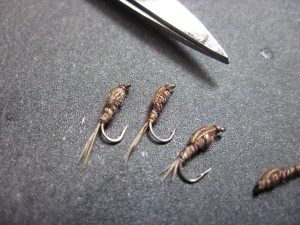By Morgan Lyle
First published in The Daily Gazette, Schenectady, N.Y.
At the risk of sounding like a curmudgeon, if a fly is tied with thread or has a peacock herl thorax, a stripe of mylar flash up its back, a bead head or legs of any kind, it’s not a pheasant tail.
I’m on a pheasant tail kick. It’s a great little fly for imitating the nymphs of blue-winged olive mayflies, which are found in just about every trout stream, but it’s also a good general pattern to use when there’s no obvious need to imitate any particular insect.
The pheasant tail’s history is fairly well known and part of its appeal. It was devised in the 1950s by a river keeper in England named Frank Sawyer. His original pheasant tail is strikingly simple: The only materials are a few fibers from one of the long tail feathers of a pheasant and very thin copper wire.
Many other nymph patterns in the same general category include more parts and tying steps, to be more “realistic.” But Sawyer’s simple little pattern has gotten anglers into nice browns on the River Avon and around the world for half a century.
One thing fly-tiers are not good at is leaving well enough alone.
Sawyer’s fly was soon Americanized with a thorax of peacock herl. Someone decided it should have legs, either the tapered tips of the pheasant tail fibers themselves or fibers from a partridge or hen feather. Beads were added at the head for all the usual reasons — to help it sink, to give it a hopping action, to give it flash, etc. Some patterns include a strip of mylar along the wing case.
All these things can be useful additions to nymphs, but whether adding them to a pheasant tail makes it more effective, I don’t know.
The original pattern’s naturally symmetrical yet slightly random segmentation is buggy as all get-out. The copper wire adds not so much flash as glow. The lack of legs is in a sense more realistic, not less, since the real nymph tucks in its legs and swims like a tiny fish. The color of the pheasant tail fibers themselves is the natural grayish-brown of the woods and rocks.
The result is not a carefully constructed model, but an immediately recognizable impression of a common and abundant insect, tasty and humming with protein.
Simple as it may be, Sawyer’s pheasant tail is tricky to tie. Both the wire and the tail feather fibers are very delicate, and a soft touch is required. Attaching the tail is unusually challenging because you can’t wrap up the shank over the butts of the tail — you need the butts for the rest of the fly. And because the entire fly is made from one bunch of feather fibers, those fibers must be long. I find two-inch fibers gives me just enough material for a size 18 fly; for larger flies like size 14s, you need two-and-a-half.
I don’t often bother tying pheasant tails larger than size 18 anyway, because that’s the size of the mayfly nymphs it imitates best. Because the only weight on the fly is the copper wire, it doesn’t sink very well, and if you need to fish it deep you may need to use a split shot or two. On the other hand, this is a very good nymph to fish to rising trout during a hatch of olives or small sulphurs, and its lightness then becomes an advantage.
These ultra-simple flies are really starting to appeal to me. Maybe it’s something to do with the rest of my life becoming ever more complicated. 
